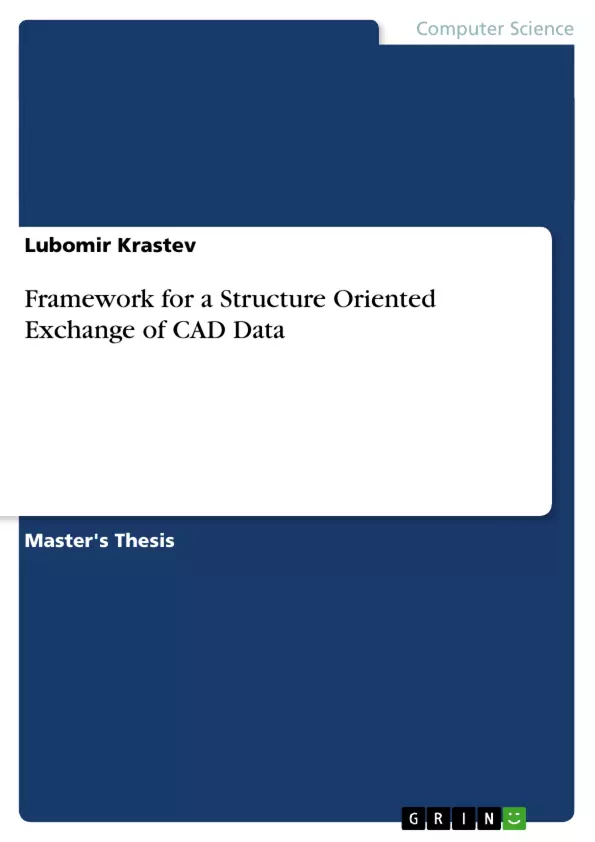Integration of a CAx (Computer Aided x) system throughout the product life
cycle and among different enterprises is a major issue for industrial
competitiveness and collaboration. One of the main successful factors for CAx
system integration is efficient methodology for EPDE (Engineering Product
Data Exchange). Data exchange is the totality of establishing the approach for
and the successful achievement of the transfer of data between two distinct
CAx systems.
Problem Statement:
- Why does an exchanged CAD (Computer Aided Design) model lose some
modelling properties? – Especially losses such as model tree (design
intent) and features.
- What reasons influence that phenomenon?
- How can these losses be minimized?
2. Review state of the art of exchange strategies
The review of exchange strategies is focused on which existing approaches
are in use today, which capabilities are supported by them, which deficiencies
they have, an understanding of state of the art is a precondition for beginning
to deal with of the problem statement.
3. Analysis of modelling capabilities regarding feature
modelling and structure representation
The analysis begins with a short review of existing feature modelling
techniques, which will build up a framework for the analysis process. Three
CAD systems are analysed – Pro/Engineering, I-DEAS and UniGraphics.
Typical models, with the frequently occurring features, are reviewed
depending on the feature modelling method and structural representation.
4. Needs-identification
The results of the analysis of modelling capabilities lead to the improvement
of new methods and techniques. This defines the essential basis for the
building of a concept framework.
5. Requirement definitions
- How can the model-tree to be exchanged?
- How will the exchanged model-tree act?
6. Outline of the thesis
The material is organized in three major sections. The first one, the state of
the art, examines the fundamentals of exchange approaches, the current
state of scientific and commercial exchange approaches and further related
technologies.
The second one, presents the current state of feature modelling techniques
and analyses of three commercial CAD systems according to feature
modelling capabilities and structural representation.
The next section, the concept framework, designs a concept framework fitting
the requirement definitions.
Inhaltsverzeichnis (Table of Contents)
- I. Introduction
- 1. Problem analysis and requirements definition
- 2. Review state of the art of exchange strategies
- 3. Analysis of modelling capabilities regarding feature modelling and structure representation
- 4. Needs-identification
- 5. Requirement definitions
- 6. Outline of the thesis
- II. Approaches to the Exchange of CAD Data
- 1. Outline
- 2. General Classification of Exchange Approaches
- 2.1. Direct and Standard-based exchange Approaches
- 2.2. Horizontal and Vertical Exchange Approaches
- 2.3. Classification of exchange strategies
- 3. Capabilities of Scientific Exchange Strategies
- 3.1. On the Implicit Exchange of Feature-Based Product Model Data
- 3.2. Exchange of CAD Part Models Based on the Macro-Parametric Approach
- 3.3. The Unified Approach to Modelling Multidisciplinary Interaction
- 3.4. An exchange Approach in Conceptual-Based Design System
- 3.5. Open CAD Environment
- 4. Capabilities of Exchange Strategies in Commercial Areas
- 4.1. Vendor Exchange Method
- 4.2. Native Exchange Method
- 4.3. Neutral Exchange Method
- 4.3.1. IGES
- 4.3.2. VDA-FS
- 4.3.3. SET
- 4.3.4. XBF
- 4.3.5. PDDI
- 4.3.6. Projects Related to Neutral Exchange Methods
- 4.3.7. STEP (ISO-10303)
- 5. Further technologies
- 5.1. Parts Library
- 5.2. CAD Services
- 5.3. ProSTEP
- 6. Conclusion
- III. Analysis of today's CAD systems - concepts and capabilities
- 1. Outline
- 2. Feature modelling definitions
- 2.1. Feature definitions
- 2.2. Feature model definition
- 2.3. Feature modelling definition
- 2.4. Feature attributes definition
- 2.5. Types of features
- 2.6. Feature properties
Zielsetzung und Themenschwerpunkte (Objectives and Key Themes)
This thesis aims to develop a framework for structure-oriented exchange of CAD model data, focusing on data that describes a product's geometric shape. The goal is to create a system that enables seamless data exchange throughout a product's life cycle, spanning various enterprises and stages of development.
- Analysis of CAD modelling capabilities regarding feature modelling and structural representation
- Survey of existing scientific and commercial strategies for exchange of CAD model data
- Specification of an overarching framework to address key technical challenges
- Illustration of the framework's functionality through a practical use case
- Exploration of the importance of structured data exchange for efficient product development and collaboration across organizations.
Zusammenfassung der Kapitel (Chapter Summaries)
The first chapter introduces the problem of exchanging CAD data and outlines the thesis's objectives. It addresses the need for robust data exchange across different stages of a product's life cycle, encompassing various enterprises. The second chapter delves into existing approaches for exchanging CAD data, categorizing them into direct and standard-based methods. It examines both scientific and commercial strategies, exploring techniques like implicit exchange, macro-parametric approaches, and neutral exchange formats.
Chapter three focuses on the analysis of today's CAD systems. It examines the concept of feature modelling and defines key elements like features, models, attributes, and types. The chapter explores the capabilities and limitations of existing CAD systems, particularly in terms of feature modelling and structural representation.
Schlüsselwörter (Keywords)
The central themes of this thesis are CAD data exchange, feature modelling, structure-oriented data representation, and product lifecycle management. The work investigates various exchange strategies, including direct, standard-based, scientific, and commercial approaches, highlighting formats like IGES, VDA-FS, SET, XBF, PDDI, and STEP.
- Quote paper
- Lubomir Krastev (Author), 2002, Framework for a Structure Oriented Exchange of CAD Data, Munich, GRIN Verlag, https://www.hausarbeiten.de/document/32714


